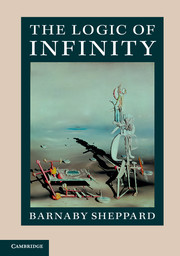Book contents
- Frontmatter
- Contents
- Preface
- Synopsis
- 1 Introduction
- 2 Logical foundations
- 3 Avoiding Russell's paradox
- 4 Further axioms
- 5 Relations and order
- 6 Ordinal numbers and the Axiom of Infinity
- 7 Infinite arithmetic
- 8 Cardinal numbers
- 9 The Axiom of Choice and the Continuum Hypothesis
- 10 Models
- 11 From Gödel to Cohen
- A Peano Arithmetic
- B Zermelo–Fraenkel set theory
- C Gödel's Incompleteness Theorems
- Bibliography
- Index
5 - Relations and order
Published online by Cambridge University Press: 05 August 2014
- Frontmatter
- Contents
- Preface
- Synopsis
- 1 Introduction
- 2 Logical foundations
- 3 Avoiding Russell's paradox
- 4 Further axioms
- 5 Relations and order
- 6 Ordinal numbers and the Axiom of Infinity
- 7 Infinite arithmetic
- 8 Cardinal numbers
- 9 The Axiom of Choice and the Continuum Hypothesis
- 10 Models
- 11 From Gödel to Cohen
- A Peano Arithmetic
- B Zermelo–Fraenkel set theory
- C Gödel's Incompleteness Theorems
- Bibliography
- Index
Summary
Cartesian products and relations
At the age of eleven, I began Euclid, with my brother as my tutor. This was one of the great events of my life, as dazzling as first love. I had not imagined there was anything so delicious in the world. From that moment until I was thirty-eight, mathematics was my chief interest and my chief source of happiness.
–Bertrand RussellFunctions and relations
The clarification of the concept of function, even when confined to the subject of analysis, had become a matter of desperate importance in the eighteenth and nineteenth centuries. Fourier's representation of piecewise continuous functions [a, b] → ℝ by trigonometric series and, later, Weierstrass and Riemann's examples of continuous nowhere differentiable functions and functions which are nowhere continuous yet integrable forced a generation of mathematicians (who were accustomed to treating functions of real variables as visualizable geometric entities) to reluctantly revise their understanding. A precise and general definition of function which is not tied to analysis is expressible within the set-theoretic framework.
Functions and relations saturate every part of mathematics. Even in our humble introduction we had to introduce these ideas at an early stage in order to construct models of the basic number systems. Now that the logical prerequisites have been brought into focus it is worth reviewing the formal definitions.
- Type
- Chapter
- Information
- The Logic of Infinity , pp. 273 - 282Publisher: Cambridge University PressPrint publication year: 2014



